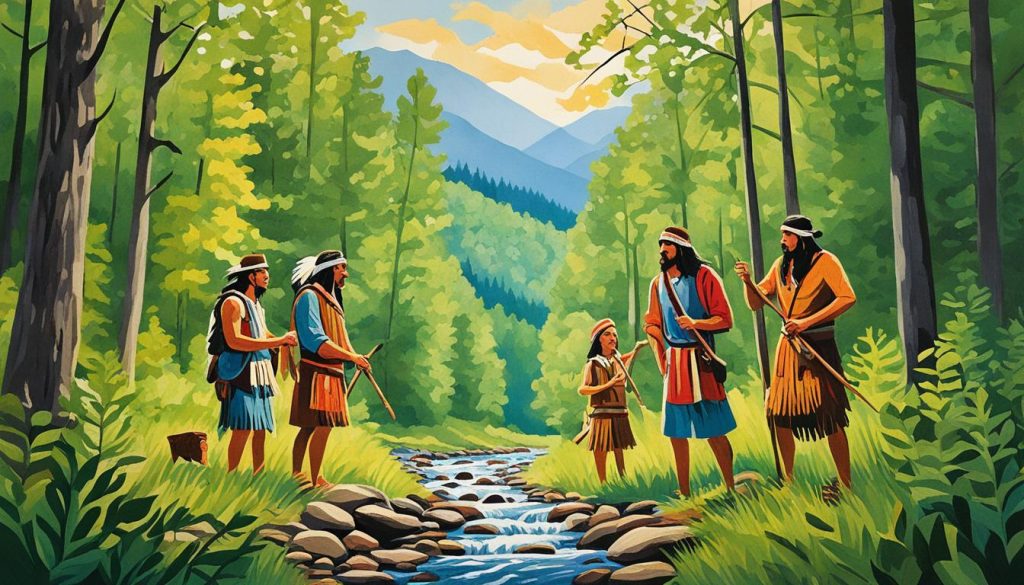
Native American History Cades Cove
Welcome to Cades Cove, a place brimming with rich Native American history. Although there is no evidence of permanent Native American settlements in this region, the indigenous peoples, including various Native American tribes, embraced the area for its abundant natural resources and as a route through the majestic Appalachian Mountains.
The Cherokee, in particular, held the Smoky Mountains, including Cades Cove, in high spiritual regard and utilized the valley for gathering plants, hunting animals, and traveling. Medicinal plants played a significant role in Cherokee culture, as they were used for healing and spiritual ceremonies.
Game hunting was also vital to the Cherokee way of life, and the wildlife-rich environment of Cades Cove provided an abundance of deer, elk, turkey, and bears. Archaeological evidence indicates that the Cherokee traveled through this area using established trails, making use of its resources.
Today, there is a partnership between the Cherokee tribe and the National Park Service, allowing tribal members to gather specific plants in the magnificent Smoky Mountains National Park. This ongoing connection emphasizes the enduring importance of Native American heritage in this sacred landscape.
Historical Settlement of Cades Cove
European settlers began to populate Cades Cove in the early 1820s, drawn to the picturesque valley and the promise of fertile land. They established their homes by building sturdy log cabins, which served as shelter for their families and a testament to their resilience. These cabins were a testament to the resourcefulness of the early settlers who cleared the land to make way for farming. The fertile soil of Cades Cove yielded abundant crops, sustaining the growing population.
As the community expanded, various community buildings emerged to meet the needs of its residents. Churches became the centerpiece of spiritual life, providing a sense of unity and faith. Schoolhouses were also established, providing education to the youth and fostering a sense of knowledge and growth within the community.
The Community
The tight-knit community of Cades Cove exemplified the spirit of camaraderie and unity. They came together for social events that celebrated their shared experiences and hard work. Corn husking, molasses making, and chestnut gathering were just a few of the activities that strengthened the bonds among the residents.
“Cades Cove was more than just a collection of log cabins; it was a place where neighbors became like family,” says historian Dr. Emily Thompson. “They relied on one another in times of hardship, be it tending to the sick, providing support during grieving, or helping with the rituals associated with death. It was truly a tight-knit community.”
As the years passed, Cades Cove continued to evolve. One significant addition to the valley was an overshot water-powered grist and flour mill. This mill became a pivotal part of the community, contributing to the local economy by providing a means to process grains and produce essential food items.
The establishment of the Great Smoky Mountains National Park, however, led to the displacement of many residents. In the 1940s, the last school and post office in Cades Cove closed, marking the end of an era for the tight-knit community that once thrived in this idyllic valley.
Transformation into a Historical Attraction
With the establishment of the Great Smoky Mountains National Park, Cades Cove underwent a remarkable transformation from a thriving mountain community to a renowned historical attraction. Originating in the 1820s, the first settlers entered the region, and their descendants continued to call Cades Cove home for generations to come. However, as Tennessee and North Carolina initiated land purchases for the national park, residents faced difficult decisions regarding the sale of their land or entering life leases.
Some families willingly chose to sell their land and relocate outside of Cades Cove, while others initially resisted but eventually had no choice but to leave their beloved community behind. Taking on the responsibility of managing and maintaining Cades Cove, the National Park Service embraced the task wholeheartedly. Recognizing its historical significance, the agency designated Cades Cove as a preserved historical area. The National Park Service diligently embarked on the restoration of the log cabins and barns, ensuring that they accurately reflected the early settlement days.
Today, Cades Cove remains a prominent destination within the encompassing beauty of the Great Smoky Mountains National Park. Visitors are drawn to its captivating wildlife, breathtaking scenic views, and well-preserved historic structures. Cades Cove stands as a testament to the rich history of the region and offers a window into the past for all who wander through its picturesque landscape.
Explore the remarkable transformation of Cades Cove into a historical attraction within the Great Smoky Mountains National Park. Immerse yourself in the captivating stories and preserved structures that reveal the unique heritage of this enchanting destination.
Exploring Native American Heritage in Cades Cove
Although the Native American presence in Cades Cove may not have included permanent settlement, their cultural significance and influence can still be explored and appreciated. The Smoky Mountains, particularly for the Cherokee people, hold spiritual and historical importance that permeates the area. When visiting Cades Cove, visitors can immerse themselves in the breathtaking beauty of the landscape and envision the traditions, practices, and deep spiritual connection to the land that were vital to Native American communities.
Throughout the region, there are historical sites and artifacts that offer glimpses into the lives of indigenous people who utilized Cades Cove for hunting, gathering, and travel. These remnants provide a tangible link to a vibrant past, allowing visitors to connect with the rich history and cultural heritage of the Native American communities that once thrived in the area.
The ongoing partnership between the Cherokee tribe and the National Park Service is a testament to the importance of preserving and honoring Native American heritage in this sacred landscape.
This collaboration recognizes the cultural significance of the Smoky Mountains and actively works to protect historical sites. It ensures that generations will continue to celebrate and remember the legacy of Native American communities.
Source Links
- https://www.nps.gov/grsm/learn/historyculture/cades-cove-history.htm
- https://gatlinburginn.com/cades-cove-history/
